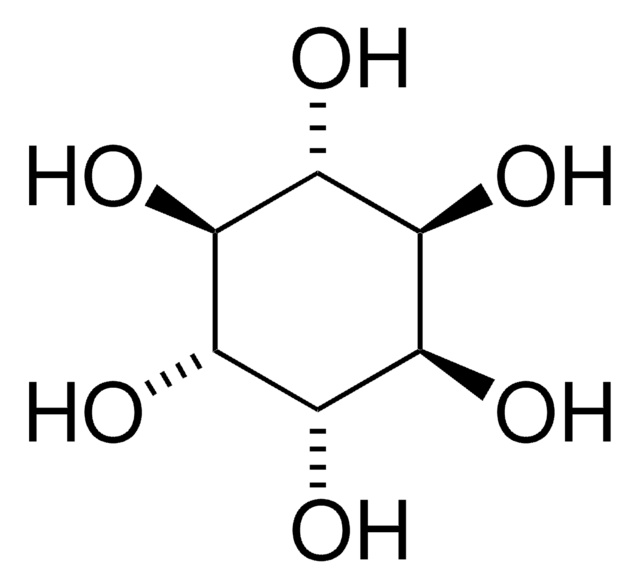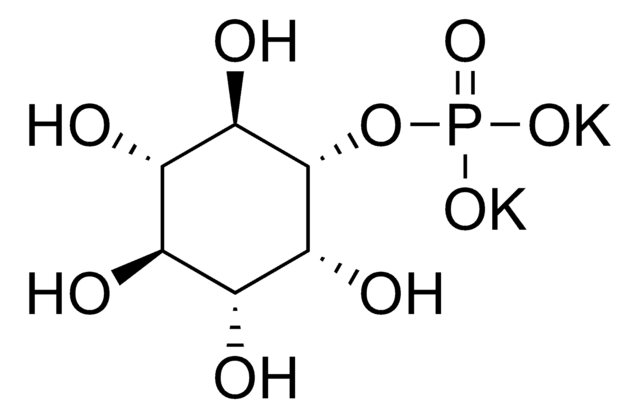I5125
myo-Inositol
≥99% (GC), powder, precursor of membrane phospho-inositides and phospholipid
Synonym(s):
1,2,3,4,5,6-Hexahydroxycyclohexane, i-Inositol, meso-Inositol
Sign Into View Organizational & Contract Pricing
All Photos(6)
About This Item
Empirical Formula (Hill Notation):
C6H12O6
CAS Number:
Molecular Weight:
180.16
Beilstein:
1907329
EC Number:
MDL number:
UNSPSC Code:
12352207
PubChem Substance ID:
NACRES:
NA.77
Recommended Products
Product Name
myo-Inositol, ≥99%
vapor density
6.2 (vs air)
Quality Level
Assay
≥99%
mp
222-227 °C (lit.)
solubility
H2O: 50 mg/mL
SMILES string
O[C@H]1[C@H](O)[C@H](O)[C@H](O)[C@@H](O)[C@@H]1O
InChI
1S/C6H12O6/c7-1-2(8)4(10)6(12)5(11)3(1)9/h1-12H/t1-,2-,3-,4+,5-,6-
InChI key
CDAISMWEOUEBRE-GPIVLXJGSA-N
Looking for similar products? Visit Product Comparison Guide
General description
myo-Inositol (MI) is a sugar-like molecule, found primarily in the glial cells of human brain. It is a stereoisomer of a C6 sugar alcohol, which is part of the inositol family. It serves as the precursor of inositol triphosphate, and as an intracellular second messenger. Myo-inositol regulates several hormones like thyroid-stimulating hormone, follicle-stimulating hormone (FSH), and insulin. Myo-inositol and d-chiro-inositol, which is another stereoisomeric form of inositol, contribute to balancing various metabolic deregulations associated with insulin resistance (IR) in different ways.
Application
myo-Inositol has been used:
- as a standard for monosaccharide analysis by gas-liquid chromatography (GC)
- as a component of R-free seahorse media for cultivation of peritoneal macrophages (PMΦs) to study cellular glycolytic metabolism
- as a SOFaaci media supplement for extending in vitro embryo growth
- as a component of α minimum essential medium (αMEM) complete media to culture natural killer (NK) cell line
Biochem/physiol Actions
myo-Inositol (MI) serves as an osmolyte and is an important precursor of membrane phospho-inositides and phospholipids. It aids in the formation of the cell membrane and myelin sheet structures. Increased concentration of myo-Inositol (MI) is observed in various brain disorders such as Alzheimer′s disease, gliomatosis cerebri, and brain tumors.
A component of membrane phospholipids, glycosylphosphatidylinositol anchors that bind glycoproteins to cell membranes, and inositol phosphate second messengers.
Storage Class Code
11 - Combustible Solids
WGK
WGK 3
Flash Point(F)
Not applicable
Flash Point(C)
Not applicable
Personal Protective Equipment
dust mask type N95 (US), Eyeshields, Gloves
Choose from one of the most recent versions:
Already Own This Product?
Find documentation for the products that you have recently purchased in the Document Library.
Customers Also Viewed
Hiroki Okada et al.
STAR protocols, 2(3), 100733-100733 (2021-08-31)
Microscopy-based analysis of protein accumulation at a given subcellular location in real time provides invaluable insights into the function of a protein in a specific process. Here, we describe a detailed protocol for determining protein accumulation kinetics at the division
Satu Hänninen et al.
Bio-protocol, 7(9), e2268-e2268 (2017-05-05)
Glycerophospholipids consist of a glycerophosphate backbone to which are esterified two acyl chains and a polar head group. The head group (e.g., choline, ethanolamine, serine or inositol) defines the glycerophospholipid class, while the acyl chains together with the head group
Carmen G Palii et al.
Cell stem cell, 24(5), 812-820 (2019-03-19)
Hematopoiesis provides an accessible system for studying the principles underlying cell-fate decisions in stem cells. Proposed models of hematopoiesis suggest that quantitative changes in lineage-specific transcription factors (LS-TFs) underlie cell-fate decisions. However, evidence for such models is lacking as TF
M Utriainen et al.
Journal of neuro-oncology, 62(3), 329-338 (2003-06-05)
The signal of choline containing compounds (Cho) in proton magnetic resonance spectroscopy (1H-MRS) is elevated in brain tumors. [11C]choline uptake as assessed using positron emission tomography (PET) has also been suggested to be higher in brain tumors than in the
Pascal M Groenen et al.
American journal of obstetrics and gynecology, 189(6), 1713-1719 (2004-01-08)
The purpose of this study was to investigate the maternal and children's myo-inositol, glucose, and zinc status in association with spina bifida risk. Sixty-three mothers and 70 children with spina bifida and 102 control mothers and 85 control children were
Our team of scientists has experience in all areas of research including Life Science, Material Science, Chemical Synthesis, Chromatography, Analytical and many others.
Contact Technical Service



